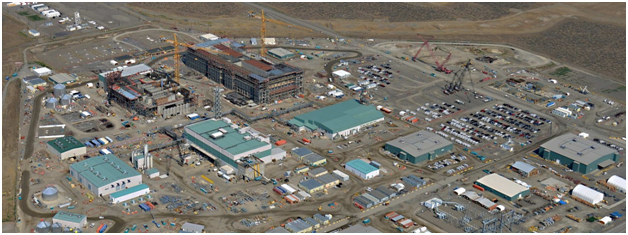I have blogged before about the vitrification plant at the Hanford Nuclear Reservation near Richland, WA. There are hundreds of buried tanks at Hanford containing mixtures of radioactive and toxic gases, liquids and solids. Work started at Hanford in 2002 on a "vitrification" plant years before they were even sure about what exactly was in the tanks. The vitrification plant was supposed to start operating in 2022 to turn the fifty six million gallons of nuclear waste in the buried tanks into glass logs which could be buried for permanent disposal. A general agreement between the State of Washington and the Department of Energy on the schedule for cleanup work that included the vitrification plant that was signed in 2010.
It turned out that the original design of the plant could have led to serious vibrations building up the piping. This could have resulted in explosions of hydrogen gas. There was also a danger that clumps of plutonium could form that might start a spontaneous chain reaction. Work was stopped on the plant in 2013 in order to solve these and other technical problems.
A technical review of the plant in 2014 was conducted by a panel that consisted of top nuclear and chemical engineers. The panel concluded that the plant had three hundred and sixty-two " significant design vulnerabilities." These problems included ventilations systems that might not be able to contain radioactive gases. There were also seals which might melt during plant operation.
As the work on the plant fell further and further behind, the State sued the DoE when it became obvious that the DoE would not be able to meet the 2022 deadline. The State acknowledged that it would be impossible for the DoE to meet the deadline. The State proposed that the plant be finished by 2034. Now the DoE has submitted a plan to the court in response to the suit where they request that the court allow them to changed the date for completion of the plant to 2039.
The original budget for the plant was set at twelve billion dollars. However, it is impossible now to predict what the eventual cost will be until the technical problems are solved and work can proceed. A public watchdog group named Hanford Challenge has pointed out that the DoE has spent almost seven hundred million dollars a year on construction of the plant for over a decade. This means that they are approaching or exceeding the original eight billion dollar estimated cost. Hanford Challenge is asking whether they intend to continue spending at this rate for twenty-five more years up to 2039.
A second major question raised by the delays has to do with when the plant could finished the task that it was designed for. Originally it was intended that the plant vitrify six tons of high-level waste a day and thirty tons of low-level waste a day. If the plant was completed by its original deadline of 2022, it could have finished vitrifying all the waste in by 2060, or about forty years. If the completion date is pushed out to 2039, it might be 2080 or later before the waste is disposed of. Some of the waste is stored in single-walled tanks which are already beginning to leak. As time goes by more and more of them will leak radioactive and toxic wastes into the soil and water table endangering public health and the environment.
The money being spent by the DoE on the vitrification plant amounts to around one tenth of one percent of the current defense budget. It would be nice if a little more of the defense budget could be spent on defending the people and the environment from the legacy of decades of nuclear weapons development that took place at Hanford.
Hanford Vitrification Plant:
